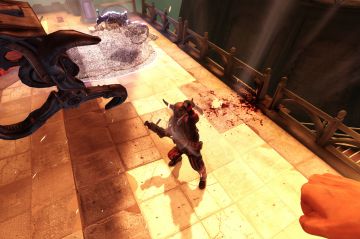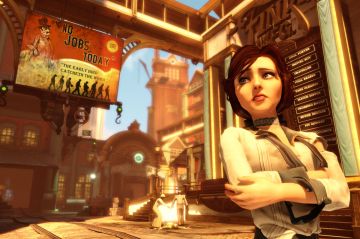I always knew that reviewing BioShock Infinite would be a challenge.
Normally, I’d follow the usual formula, talking about the game’s high points and low points, and slapping a score on the bottom.
But BioShock Infinite isn’t formulaic. Here’s a game that in two weeks has already prompted more smart commentary than most games will ever see. It has a reputation for being that kind of game–the one you approach intellectually, despite its grisly facade of smashed skulls, burnt bodies and cartoonish gore. The same was true with the original BioShock, and with the spiritually-related System Shock series before that. BioShock Infinite wants you to have your mindless fun, but it also wants you to ponder.
Let’s back up. On the surface, BioShock Infinite is about shooting enemies in the face, clubbing them over the head, lighting them on fire, electrocuting them, drowning them in tidal waves and–in the most fiendish case–sending murderous flocks of crows to peck at their flesh. Like the original BioShock, combat is a combination of weird genetic superpowers and plain old firearms. Over and over, the game hurls a handful of sharp-shooting enemies at you, and forces you to quickly come up with a strategy.
For me, that meant employing the same strategy from start to finish: Find some cover, use the ghostly Possession skill to turn an enemy over to my side, pick off a few enemies amid the resulting commotion, repeat. Almost every skill upgrade and weapon enhancement I made was in service of this winning battle plan, with the exception of improving my fire bombs and charge attacks for the occasional boss battle. And this was on the hardest difficulty setting.

As far as RPG-tinged shooters go, BioShock Infinite is just okay. The level of gore is perhaps a bit excessive, as some critics have argued. But the violence isn’t the substance of the game. It exists, in a Tarantino-like way, to put butts in seats. It also sets the rhythm, with each violent crescendo making you eager for Infinite’s quieter moments of storytelling.
BioShock Infinite dreams up an early 20th century America that never was, where a floating city called Columbia has rejected the nation below. Up here, the residents worship our Founding Fathers as idols, and pray to a man named Comstock who’s fashioned himself as a prophet. It’s creepy in theory, but it looks idyllic. You can easily spend the first 15 minutes of the game wondering the streets, soaking up the prim culture and listening to a barbershop quartet cover the Beach Boys. (This is an alternate history, after all.)
But Columbia’s ugly side eventually comes out. Behind the beautiful facade, an oppressed underclass keeps the city ticking, while the upper crust embraces racism, jingoism and religious superiority as part of the culture. The city’s highest level of defense comes in the form of chaingun-toting, patriotic proverb-shouting, motorized colonial heroes. Columbia isn’t so much an alternate reality as it is a caricature of American history and politics, and this America is very much a force of evil. Call of Duty, this is not.

BioShock Infinite explores these notions mainly over its first few hours, during which the plot is still ostensibly about rescuing a damsel in distress named Elizabeth. It’s another trope that BioShock Infinite dismantles, as Elizabeth spends most of the game alongside protagonist Booker Dewitt, serving as a valuable combat medic and supply gopher. She becomes the savior, and Dewitt, a former Pinkerton agent with a troubled past, is the one who needs redemption. The story that follows is much more complicated, taking you on a tour of Columbia’s dark corners and eventually dipping into the multiverse.
What BioShock Infinite ends up with is a stew of ideas, revolving around the perils of American conservatism, or American politics in general. While the message isn’t as tidy as the original BioShock (hey, Objectivism doesn’t really work!) it also seems weightier and more topical. It’s not the most intellectually clever story–Daniel Golding makes a strong argument that Infinite’s themes lack appropriate nuance–but then again, neither is Django Unchained. As Tarantino has cheerily admitted, his goal was to start a conversation. “I am responsible for people talking about slavery in America in a way that they have not in 30 years,” Tarantino said in January. When was the last time a video game made you think about the Wounded Knee Massacre? The value of BioShock Infinite isn’t the violence, or the story itself, but everything that comes after.
When evaluated on traditional grounds, Bioshock Infinite isn’t perfect. As with the previous BioShock games, it requires far too much resource scavenging from dead bodies and abandoned cabinets. It has strayed farther from the role-playing roots of its spiritual ancestor, System Shock, and combat feels too constrained as a result. Some of the game’s early ideas, like prolonged boss encounters and story-altering decisions, seemed to be abandoned partway through.
None of that stopped me from being sucked into BioShock Infinite’s world, and then being floored by its conclusion. It’s the kind of game you want to think about and talk about long after the credits roll, which is why the pile of thoughtful critiques keeps growing. You should play it, and join the conversation.
Score: 5 out of 5
Version reviewed: PC

